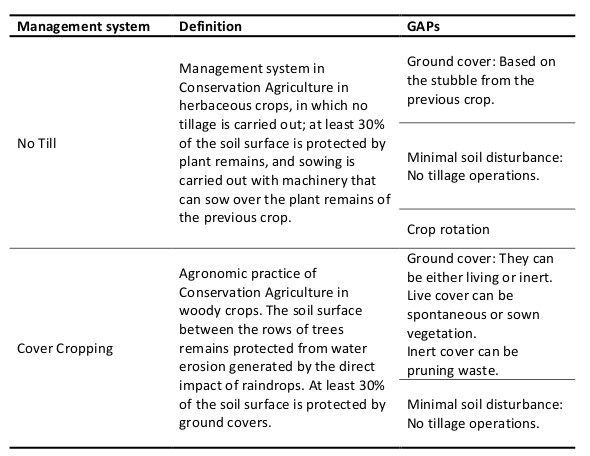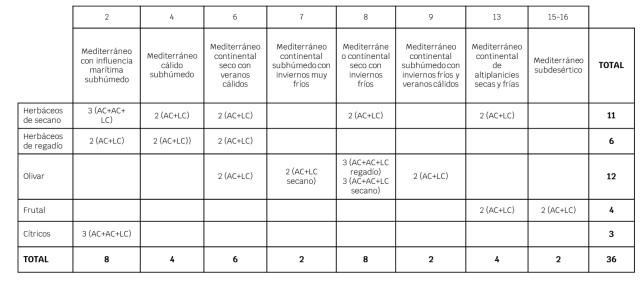RESULTS PREPARATORY ACTIONS
This action aims at identifying and defining the agricultural practices that are being implemented and monitored in the framework of the project. This action also includes the definition of indicators to monitor the effectiveness in increasing the soil carbon content in particular, mitigating climate change in general, as well as the effectiveness in other parameters in the environmental, social and economic spheres.
As a result of the tasks undertaken in the action, the following Good Agricultural Practices (GAPs) have been defined which, in turn, are the ones that make up the management systems that are being implemented in the project:
- Mantaining vegetation cover on the soil: This means keeping stubble on the soil in arable crops and sowing or maintaining vegetation cover, either live or inert, between the rows of trees in woody crops. At least 30% of the soil should be covered after sowing to protect it effectively against erosion. However, coverages higher than 60% are desirable in order to have almost total control over this soil degradation process.
- Minimal mechanical soil disturbance: Minimal disturbance consists of avoiding, as far as possible, mechanical soil disturbance for the development of agricultural activity on the soil. This means not carrying out any type of work on the soil. Establishment of crop rotations: Crop rotation consists of the successive sowing of different arable crops on the same piece of land, following a defined order. This concept contrasts with monoculture, which consists of the repeated sowing of the same species on the same plot of land, year after year.
The management systems defined on the basis of these GAPs are shown in the following table:

The definition and the way to implement the GAPs identified in the framework of the project are included in a manual of agricultural practices to mitigate climate change.
Another of the results achieved within the framework of this action has been the establishment of a set of 29 indicators for monitoring the environmental, economic and social benefits obtained thanks to the use of these management systems.
The aim of this action is to establish different agro-climatic zones in the Andalusian region, a unit of analysis at regional level for implementation and monitoring actions, in order to establish representative areas with regard to climate, soil types and crops. This zoning makes it possible to establish a network of farms which characterises the agricultural system at regional level and, therefore, makes it possible for the implementation and monitoring actions to cover most of the cases of the Andalusian agricultural reality.
Thanks to the tasks undertaken in the action, a digital coverage has been generated with the sectorisation, from which statistics and locations can be extracted according to criteria of representativeness. A total of 8 sectors have been defined in the study region (Image 1)
- Mediterranean with maritime influence sub-humid.
- Warm sub-humid Mediterranean.
- Dry continental Mediterranean with hot summers.
- Sub-humid continental Mediterranean with very cold winters.
- Dry continental Mediterranean with cold winters.
- Subhumid continental Mediterranean with cold winters and hot summers.
- Continental Mediterranean of dry and cold high plateaus.
- Sub-desert Mediterranean.
The aim of this action is to establish a network of demonstration farms on a regional scale, which is representative of the main crops in the region, on which to carry out the project's implementation and monitoring actions.
Based on the steps taken, a total of 36 demonstration farms have been selected for the implementation and monitoring actions at regional level, whose characteristics in terms of type of crop and management system used are shown in the following table:

CA: Conservation Agriculture (Direct Sowing in arable crops, ground coversin Olive, Fruit and Citrus).
LC: Conventional Tillage.
More information here .This post is also available in: Español (Spanish)

